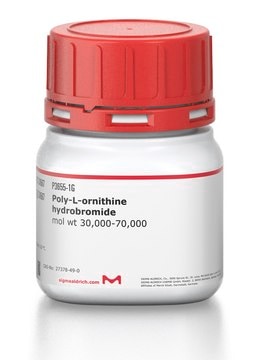L2020
Mouse Laminin
from Engelbreth-Holm-Swarm murine sarcoma basement membrane, 0.2 μm filtered, liquid, 1-2 mg/mL, suitable for cell culture
Synonym(s):
Laminin
About This Item
Recommended Products
Product Name
Laminin from Engelbreth-Holm-Swarm murine sarcoma basement membrane, 1-2 mg/mL in Tris-buffered saline, 0.2 μm filtered, BioReagent, suitable for cell culture
biological source
mouse (Engelbreth-Holm-Swarm mouse sarcoma basement membrane)
Quality Level
product line
BioReagent
form
aqueous solution
mol wt
A subunit 400 kDa
B1 subunit 210 kDa
B2 subunit 200 kDa
packaging
pkg of 1 mg
concentration
1-2 mg/mL in Tris-buffered saline
technique(s)
cell culture | mammalian: suitable
surface coverage
1‑2 μg/cm2
impurities
Microbial Contamination, passes test
NCBI accession no.
Binding Specificity
Peptide Source: Collagen
shipped in
dry ice
storage temp.
−20°C
Gene Information
mouse ... Lama1(16772) , Lamb1(16777) , Lamc1(226519) , Lamc2(16782)
Looking for similar products? Visit Product Comparison Guide
General description
Application
- insulin-producing cell (IPC) differentiation.
- Infection inhibition assays.
- Proliferation Assay.
Biochem/physiol Actions
Components
Caution
Preparation Note
related product
Storage Class Code
11 - Combustible Solids
WGK
WGK 3
Flash Point(F)
Not applicable
Flash Point(C)
Not applicable
Personal Protective Equipment
Choose from one of the most recent versions:
Certificates of Analysis (COA)
Don't see the Right Version?
If you require a particular version, you can look up a specific certificate by the Lot or Batch number.
Already Own This Product?
Find documentation for the products that you have recently purchased in the Document Library.
Customers Also Viewed
Articles
Attachment Factors for 3-Dimensional Cell Culture
Hydrogela are the most widely used systems for 3D cell culture. Learn more about this technology (what are hydrogels? How to chose?)
The extracellular matrix (ECM) is secreted by cells and surrounds them in tissues.
Frequently asked questions about neural stem cells including NSC derivation, expansion and differentiation.
Protocols
A stem cell culture protocol to generate 3D NSC models of Alzheimer’s disease using ReNcell human neural stem cell lines.
Step-by-step culture protocols for neural stem cell culture including NSC isolation, expansion, differentiation and characterization.
Our team of scientists has experience in all areas of research including Life Science, Material Science, Chemical Synthesis, Chromatography, Analytical and many others.
Contact Technical Service








